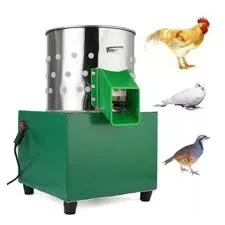Scalding Process for Poultry Production Explained in Detail
Nov . 06, 2024 01:09 Back to list
Scalding Process for Poultry Production Explained in Detail
Understanding Scalding Tanks in Poultry Processing
The poultry industry is a vital component of the global food supply chain, providing billions of pounds of chicken, turkey, and other birds to consumers each year. One of the critical steps in processing these animals involves scalding, a method used to prepare birds for plucking. At the heart of this process is the scalding tank, a specialized piece of equipment that plays a crucial role in ensuring the efficiency of poultry processing.
What is a Scalding Tank?
A scalding tank is a heated vessel where newly slaughtered poultry is submerged in hot water. The primary purpose of this process is to loosen the feathers from the skin of the bird, making it easier and more efficient to remove them during the plucking stage. Typically, scalding tanks are designed to accommodate various sizes and types of poultry, including chickens, turkeys, and ducks.
The Science of Scalding
Scalding involves raising the temperature of the birds' skin and feathers to a level that facilitates feather removal. Generally, temperatures range from 130°F to 160°F (54°C to 71°C), depending on the species and the method of processing. The time spent in the scalding tank is also crucial; too little time may not loosen the feathers adequately, while too much can cause damage to the skin and meat.
The hot water penetrates the outer feathers and affects the skin's structure, denaturing proteins and allowing for easier extraction of the feathers during the subsequent plucking process. This step is pivotal in ensuring the quality of the final product, as effective plucking can significantly reduce the amount of residual feathers, which is essential for consumer acceptance.
Importance of Scalding Tanks in Poultry Processing
1. Efficiency Scalding tanks significantly increase the overall efficiency of the poultry processing line. By enabling faster feather removal, processors can enhance throughput and reduce operation times.
2. Quality Assurance The effectiveness of the scalding process greatly influences the final quality of the poultry. Proper scalding ensures not only that feathers are removed cleanly, but also that the meat retains its quality without excess damage or bruising.
3. Hygiene Standards Scalding tanks contribute to the hygiene and safety of poultry products. The hot water helps to kill bacteria and other pathogens that may be present on the bird's surface, thus ensuring compliance with food safety standards.
scalding tank poultry

4. Customization Modern scalding tanks can be adjusted for different bird species and sizes, allowing processors to tailor the scalding process for optimal results. This ensures that facilities can remain versatile and adaptive to market demands.
Types of Scalding Tanks
There are primarily two types of scalding tanks used in the poultry industry batch scalders and continuous scalders.
- Batch Scalders These are typically larger tanks where a batch of birds is submerged at once. After the allotted scalding time, birds are removed and sent directly to plucking. Batch scalders are often used for smaller operations or specialty poultry processing.
- Continuous Scalders In larger processing facilities, continuous scalders employ a conveyor belt system. Birds are introduced at one end of the tank and continuously move through hot water before exiting plucking machines. This setup allows for high-volume processing and is favored in commercial poultry plants.
Challenges and Innovations
While scalding tanks are essential, they are not without their challenges. Maintaining optimal water temperatures and ensuring consistent heat distribution can be difficult. Innovations in the design of scalding tanks, such as adjustable temperature controls and improved insulation, help address these issues.
Additionally, as the poultry industry becomes increasingly aware of environmental concerns, many companies are exploring more eco-friendly scalding methods. Systems that recycle water and use alternative heat sources are gaining traction, showcasing the industry's commitment to sustainability.
Conclusion
Scalding tanks are indispensable in the poultry processing industry, facilitating efficient feather removal, enhancing product quality, and ensuring food safety. As technology advances and processing demands evolve, the role of scalding tanks will continue to be vital in meeting consumer expectations for high-quality poultry products. Understanding their function and importance is key for anyone invested in the poultry supply chain, from processors to consumers.
-
Hot Sale 24 & 18 Door Rabbit Cages - Premium Breeding Solutions
NewsJul.25,2025
-
Automatic Feeding Line System Pan Feeder Nipple Drinker - Anping County Yize Metal Products Co., Ltd.
NewsJul.21,2025
-
Automatic Feeding Line System Pan Feeder Nipple Drinker - Anping County Yize Metal Products Co., Ltd.
NewsJul.21,2025
-
Automatic Feeding Line System - Anping Yize | Precision & Nipple
NewsJul.21,2025
-
Automatic Feeding Line System - Anping Yize | Precision & Nipple
NewsJul.21,2025
-
Automatic Feeding Line System-Anping County Yize Metal Products Co., Ltd.|Efficient Feed Distribution&Customized Animal Farming Solutions
NewsJul.21,2025






